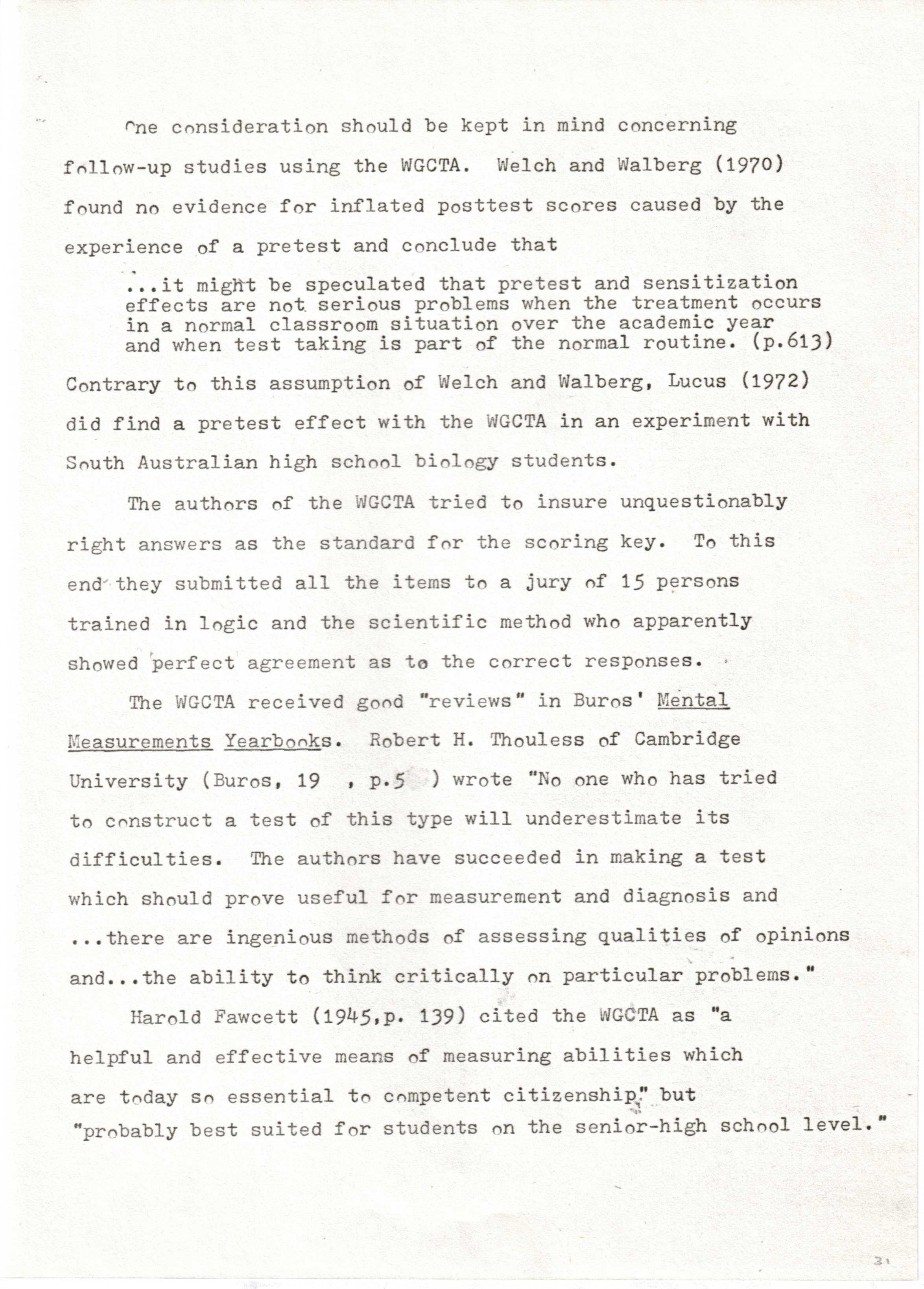
ctomeegmiu31.jpg
|
One consideration should be kept in mind
concerning
follow-up studies using the WGCTA. Welch
and Walberg (1970)
found no evidence for inflated posttest
scores caused by the
experience of a pretest and conclude that
- :..it might be speculated that pretest and
sensitization
effects are not serious problems when the
treatment occurs
in a normal classroom situation over the
academic year
and when test taking is part of the normal
routine. (p.613)
Contrary to this assumption of Welch and
Walberg, Lucus (1972)
did find a pretest effect with the WGCTA in
an experiment with
South Australian high school biology
students.
The authors of the WGCTA tried to insure
unquestionably
right answers as the standard for the
scoring key. To this
end they submitted all the items to a jury of 15 persons
trained in logic and the scientific method
who apparently
showed perfect agreement as to the correct responses.
The WGCTA received good 'reviews" in Burns' Mental
Measurements Yearbooks. Robert H. Thouless
of Cambridge
University (Buros, 19 . p.§ ) wrote "No one
who has tried
to construct a test of this type will
underestimate its
difficulties. The authors have succeeded in
making a test
which should prove useful for measurement
and diagnosis and
...there are ingenious methods of assessing
qualities of opinions
and...the ability to think critically on particular problems."
Harold Fawcett (1945,p. 139) cited the WGCTA as “a
helpful and effective means of measuring
abilities which
are today so essential to competent
citizenship" but
"probably best suited for students on the
senior-high school level."
|

ctomeegmiu32.jpg
|
Walker H. Hill of Michigan State University
(Buros, 19 ,
p.796) wrote that ”If, as this reviewer
believes, critical
thinking is a central goal of education,
serious efforts to
understand it and appraise it must be
encouraged...and the Watson-Glaser Critical Thinking Appraisal
is one of the useful
instruments for this purpose.” But he urged
caution in the
use of subtest scores. He cited as a
"loophole" in the
inference subtest the required use of
”certain commonly
accepted knowledge or information which
practically every
person knows" as stated in the WGCTA
Manual. Hill also
found the norms to be based on a
”regrettably limited college
population. "
Carl I. Hovland of Yale University (Buros,
19 , p.797)
wrote “The Watson-Glaser test is a
conscientious, imaginative
effort to provide appraisal in a most
difficult area--that
of 'critical thinking'." Hovland also found
the norms in
the manual ”quite sketchy". He mentioned
that it is critical
to take into account which form of the WGCTA one uses in a study
because of differences ranging up to six
points. Hovland also said
that since the theoretical relationship
between critical thinking
I and other measures of intelligence is not established, it is difficult to asses whether the correlation of
.70 reported between
this test and the Terman-McNemar Test of
Mental Ability means
that the Watson-Glaser test is measuring a
single major aspect
of intelligence or is just another form of
intelligence test."
|
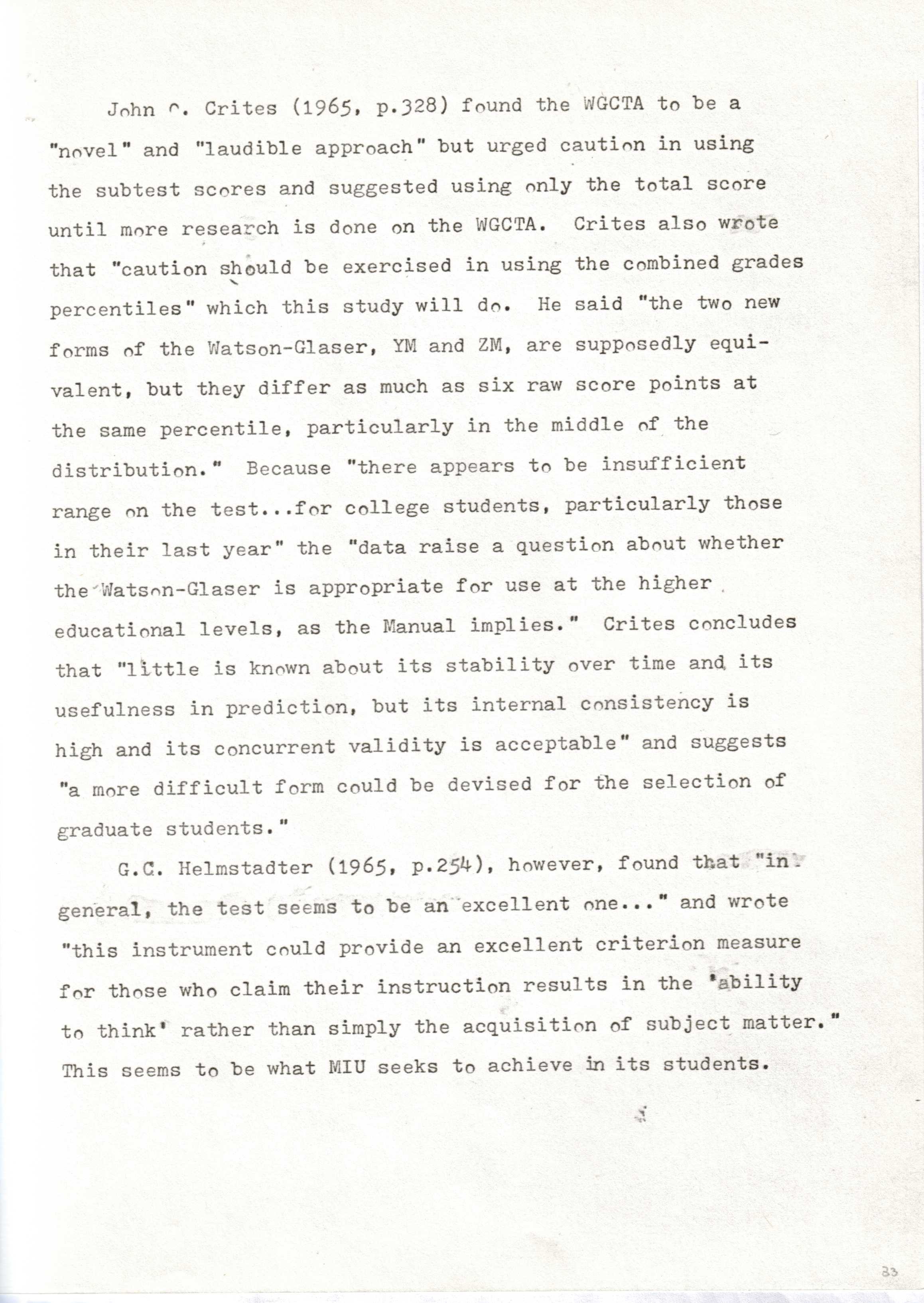
ctomeegmiu33.jpg
|
John P. Crites (1965, p.328) found the
WGCTA to be a
"novel" and "laudable approach" but urged
caution in using
the subtest scores and suggested using only
the total score
until more research is done on the WGCTA.
Crites also wrote
that "caution should be exercised in using
the combined grades
percentiles" which this study will do. He
said ”the two new
forms of the Watson-Glaser, YM and ZM, are
supposedly equivalent, but they differ as much as six raw
score points at
the same percentile, particularly in the
middle of the
distribution.” Because "there appears to be
insufficient
range on the test...for college students, particularly those
in their last year" the “data raise a
question about whether
the Watson-Glaser is appropriate for use at the higher
educational levels, as the Manual implies."
Crites concludes
that "little is known about its stability
over time and its
usefulness in prediction, but its internal
consistency is
high and its concurrent validity is
acceptable" and suggests
"a more difficult form could be devised for
the selection of
graduate students."
G.C. Helmstadter (1965, p.254) however,
found that "in
general, the test seems to be an excellent
one..." and wrote
"this instrument could provide an excellent
criterion measure
for those who claim their instruction
results in the 'abi1ity
to think' rather than simply the
acquisition of subject matter."
This seems to be what MIU seeks to achieve in its students.
|
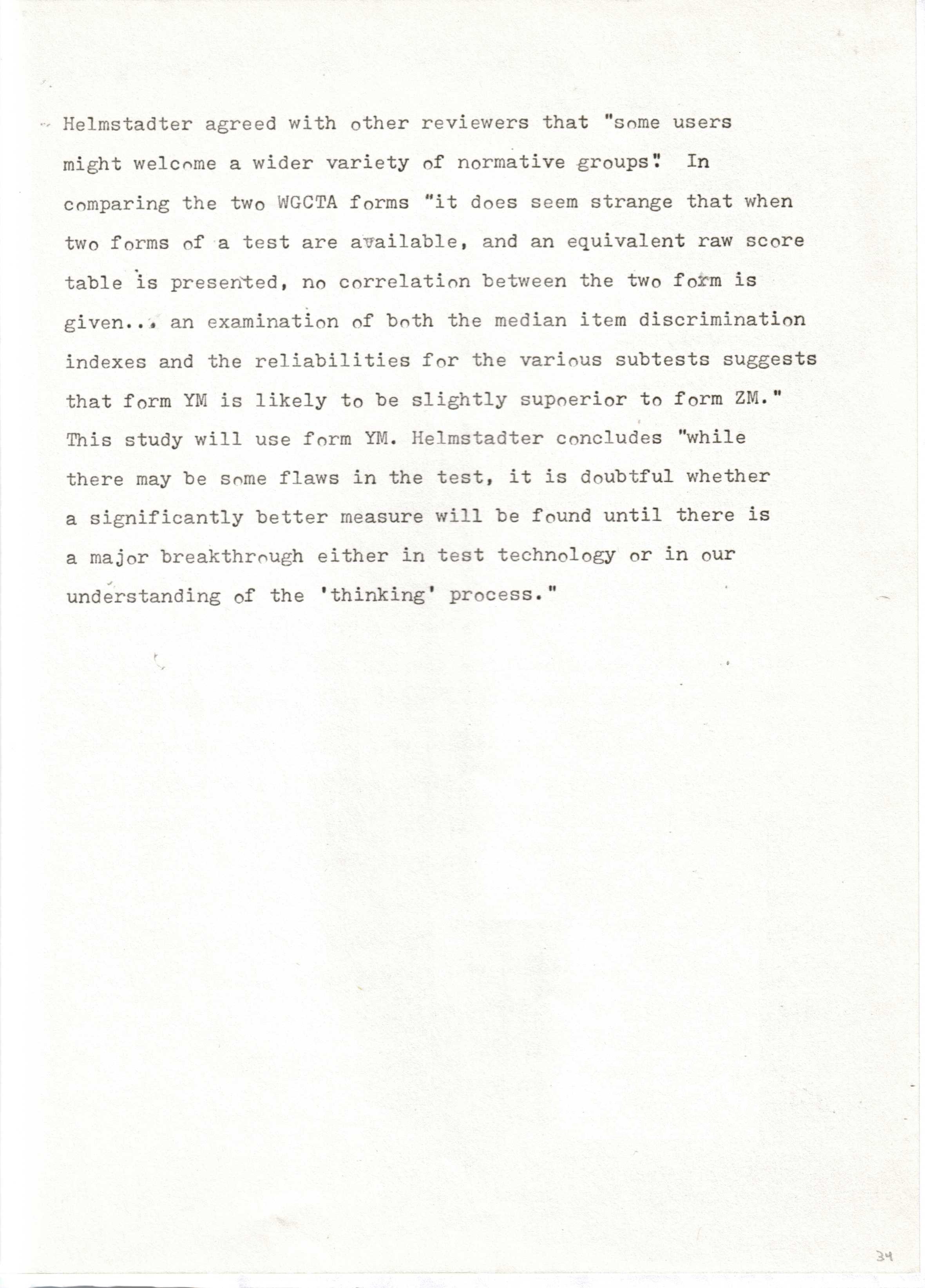
ctomeegmiu34.jpg
|
Helmstadter agreed with other reviewers
that ”some users
might welcome a wider variety of normative
groups". In
comparing the two WGCTA forms “it does seem
strange that when
two forms of a test are available. and an
equivalent raw score
table is presented, no correlation between
the two form is
given... an examination of both the median
item discrimination
indexes and the reliabilities for the
various subtests suggests
that form YM is likely to be slightly
superior to form ZM."
This study will use form YM. Helmstadter
concludes ”while
there may be some flaws in the test, it is
doubtful whether
a significantly better measure will be
found until there is
a major breakthrough either in test
technology or in our understanding of the 'thinking' process."
|
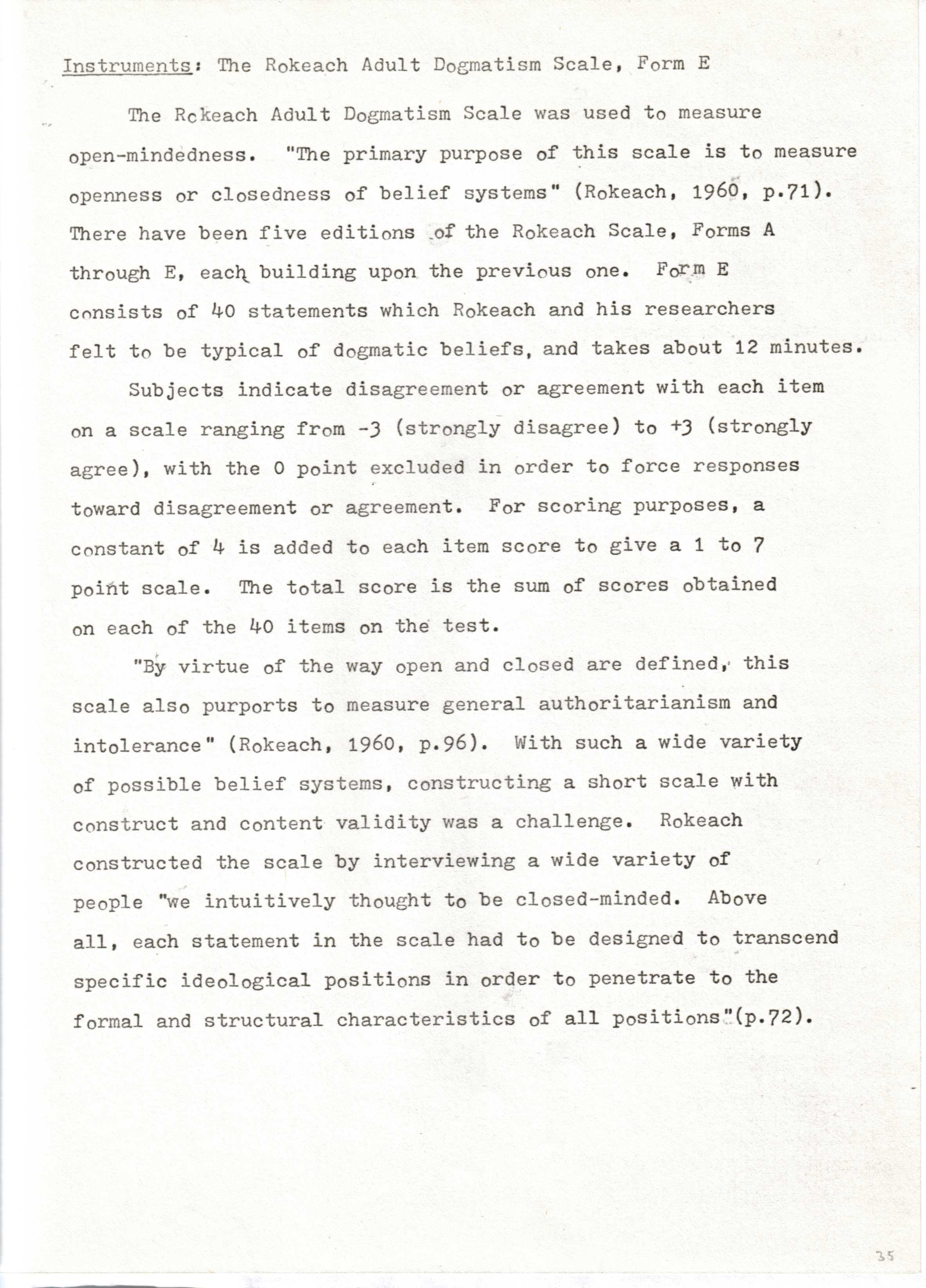
ctomeegmiu35.jpg
|
Instruments: The Rokeach Adult Dogmatism Scale, Form E
The Rokeach Adult Dogmatism Scale was used
to measure
open-mindedness. "The primary purpose of
this scale is to measure
openness or closedness of belief systems”
(Rokeach. 1966, p.71).
There have been five editions of the
Rokeach Scale, Forms A
through E, each building upon the previous
one. Form E
consists of no statements which Rokeach and
his researchers felt to be typical of dogmatic beliefs,
and takes about 12 minutes.
Subjects indicate disagreement or agreement
with each item
on a scale ranging from -3 (strongly
disagree) to +3 (strongly
agree), with the 0 point excluded in order
to force responses
toward disagreement or agreement. For
scoring purposes, a
constant of 4 is added to each item score
to give a 1 to 7
point scale. The total score is the sum of
scores obtained
on each of the no items on the test.
"By virtue of the way open and closed are
defined, this
scale also purports to measure general
authoritarianism and
intolerance" (Rokeach, 1960, p.96). with
such a wide variety
of possible belief systems, constructing a
short scale with
construct and content validity was a
challenge. Rokeach
constructed the scale by interviewing a
wide variety of
people "we intuitively thought to be
closed-minded. Above
all, each statement in the scale had to be
designed to transcend
specific ideological positions in order to
penetrate to the
formal and structural characteristics of
all positions” (p.72).
|
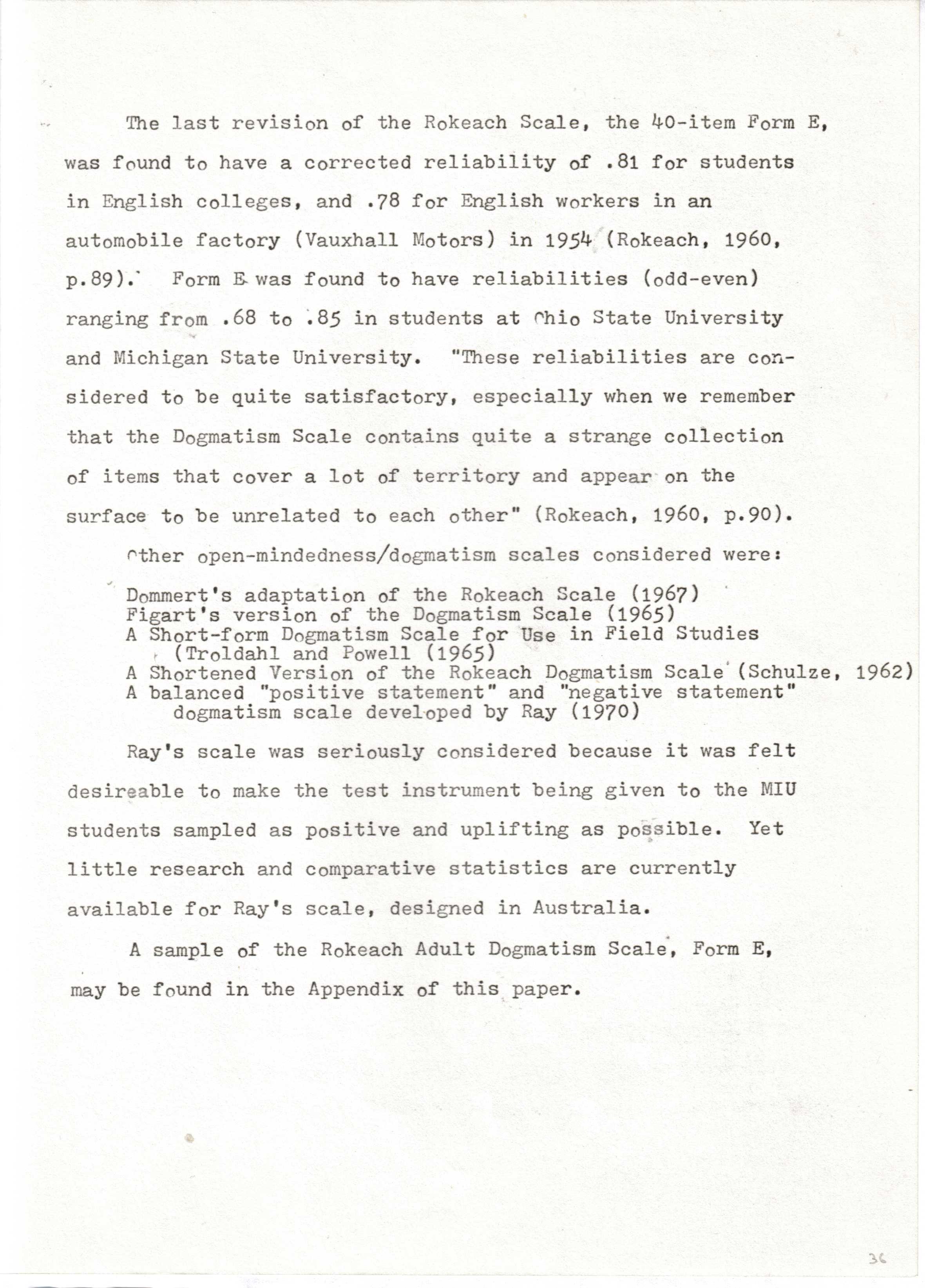
ctomeegmiu36.jpg
|
The last revision of the Rokeach Scale,
the 40-item Form E, was found to have a corrected reliability
of .81 for students
in English colleges, and .78 for English
workers in an
automobile factory (Vauxhall Motors) in
1959 (Rokeach, 1960,
p.89).` Form E was found to have
reliabilities (odd-even)
ranging from .68 to .85 in students at Ohio
State University
and Michigan State University. "These reliabilities are considered to be quite satisfactory,
especially when we remember
that the Dogmatism Scale contains quite a
strange collection of items that cover a lot of territory and
appear on the
surface to be unrelated to each other"
(Rokeach, 1960, p.90).
Other open-mindedness/dogmatism scales
considered were:
Dommert's adaptation of the Rokeach Scale (1967)
Figart's version of the Dogmatism Scale
(1965)
A Short-form Dogmatism Scale for Use in
Field Studies
(Troldahl and Powell (1965)
A Shortened Version of the Rokeach
Dogmatism Scale (Schulze, 1962)
A balanced "positive statement” and
"negative statement"
dogmatism scale developed by Ray (1970)
Ray's scale was seriously considered
because it was felt
desirable to make the test instrument
being given to the MIU
students sampled as positive and uplifting
as possible. Yet
little research and comparative statistics
are currently
available for Ray's scale, designed in
Australia.
A sample of the Rokeach Adult Dogmatism
Scale} Form E,
may be found in the Appendix of this paper.
|